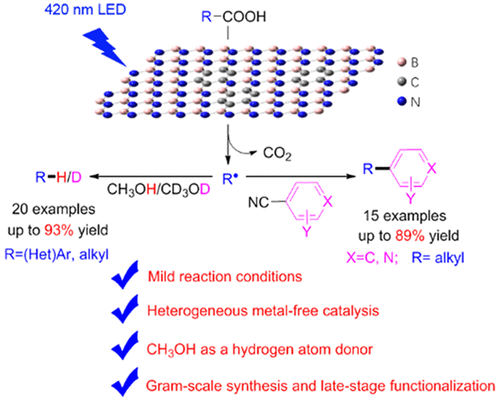当前位置:
X-MOL 学术
›
ACS Catal.
›
论文详情
Our official English website, www.x-mol.net, welcomes your
feedback! (Note: you will need to create a separate account there.)
Metal-Free Heterogeneous Semiconductor for Visible-Light Photocatalytic Decarboxylation of Carboxylic Acids
ACS Catalysis ( IF 11.3 ) Pub Date : 2021-02-23 , DOI: 10.1021/acscatal.0c05211 Jiale Shi 1 , Tao Yuan 1 , Meifang Zheng 1 , Xinchen Wang 1
ACS Catalysis ( IF 11.3 ) Pub Date : 2021-02-23 , DOI: 10.1021/acscatal.0c05211 Jiale Shi 1 , Tao Yuan 1 , Meifang Zheng 1 , Xinchen Wang 1
Affiliation

|
A suitable protocol for the photocatalytic decarboxylation of carboxylic acids was developed with metal-free ceramic boron carbon nitrides (BCN). With visible light irradiation, BCN oxidize carboxylic acids to give carbon-centered radicals, which were trapped by hydrogen atom donors or employed in the construction of the carbon–carbon bond. In this system, both (hetero)aromatic and aliphatic acids proceed the decarboxylation smoothly, and C–H, C–D, and C–C bonds are formed in moderate to high yields (35 examples, yield up to 93%). Control experiments support a radical process, and isotopic experiments show that methanol is employed as the hydrogen atom donor. Recycle tests and gram-scale reaction elucidate the practicability of the heterogeneous ceramic BCN photoredox system. It provides an alternative to homogeneous catalysts in the valuable carbon radical intermediates formation. Moreover, the metal-free system is also applicable to late-stage functionalization of anti-inflammatory drugs, such as naproxen and ibuprofen, which enrich the chemical toolbox.
中文翻译:

不含金属的多相半导体用于羧酸的可见光光催化脱羧
用不含金属的陶瓷氮化硼碳(BCN)开发了一种适合的光催化脱羧羧酸的方法。在可见光照射下,BCN将羧酸氧化成以碳为中心的自由基,这些自由基被氢原子供体俘获或用于构建碳-碳键。在该系统中,(杂)芳族和脂肪族酸均能顺利进行脱羧反应,并以中等至高收率形成C–H,C–D和C–C键(35个实例,最高收率93%)。对照实验支持自由基过程,同位素实验表明甲醇被用作氢原子供体。循环测试和克级反应阐明了异质陶瓷BCN光氧化还原系统的实用性。它为有价值的碳自由基中间体的形成提供了均相催化剂的替代方法。此外,不含金属的系统还适用于消炎药(如萘普生和布洛芬)的后期功能化,这些功能丰富了化学工具箱。
更新日期:2021-03-05
中文翻译:

不含金属的多相半导体用于羧酸的可见光光催化脱羧
用不含金属的陶瓷氮化硼碳(BCN)开发了一种适合的光催化脱羧羧酸的方法。在可见光照射下,BCN将羧酸氧化成以碳为中心的自由基,这些自由基被氢原子供体俘获或用于构建碳-碳键。在该系统中,(杂)芳族和脂肪族酸均能顺利进行脱羧反应,并以中等至高收率形成C–H,C–D和C–C键(35个实例,最高收率93%)。对照实验支持自由基过程,同位素实验表明甲醇被用作氢原子供体。循环测试和克级反应阐明了异质陶瓷BCN光氧化还原系统的实用性。它为有价值的碳自由基中间体的形成提供了均相催化剂的替代方法。此外,不含金属的系统还适用于消炎药(如萘普生和布洛芬)的后期功能化,这些功能丰富了化学工具箱。











































 京公网安备 11010802027423号
京公网安备 11010802027423号